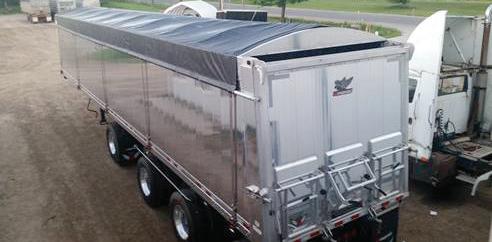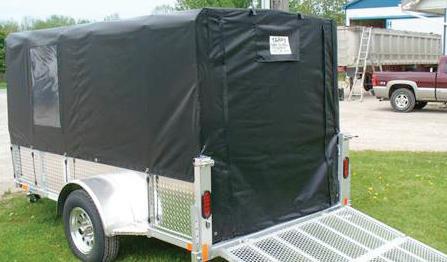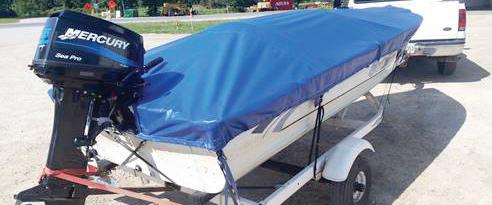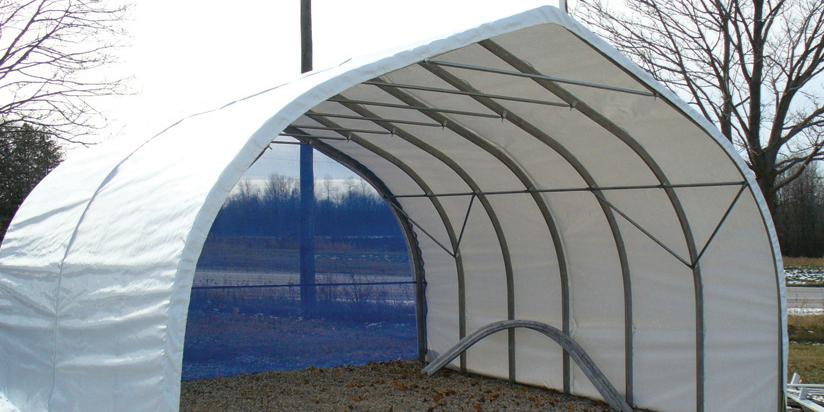








Technology is constantly changing the way farm tasks are completed –mostly for the better.

At Doug Andriessen Farms in the Wallace Ward of North Perth, 2022 marked a new era as they went from milking by hand in the parlour to a fully robotic system.
The 135 cows in the barn have taken quite well to the new technology, according to Doug Andriessen.

“It didn’t take them long to get used to it,” said Doug Andriessen, who operates the farm with sons Kyle and Noah. Work to convert the barn to the new technology began at the start of January,

however plans were finalized last summer.
Once the Andriessens finalized their design, contractors were lined up and the work was done in about five or six weeks, Andriessen said.
All of the work in the barn was done by local contractors, something Andriessen was quick to point out.
See ANDRIESSEN page 10



 KELSEY BENT
KELSEY BENT
Marmeadow Farms Ltd. is a family-owned dairy operation in Britton, Perth County. The farm is currently owned by fourth-generation farmers Bob and Susan Martin, and operated by fifth-generation farmers, Tim and Jenn Martin.
The farm was purchased in 1893 by Ezekiel Martin, Bob’s grandfather, and it has remained in the Martin family name for 129 years.
As far back as anyone can remember, the Martin farmers have always had livestock.
Before falling under Martin ownership, this plot of land only had two other owners.
Two generations of the Alexander family owned the land from 1854-93 when they sold to Ezekiel.
Bob recalls that his ancestors immigrated from Ireland in the early 1860s and settled in Edgecomb (located at the corner of Line 72 and Road 131).
He recalls they owned a small farm there before purchasing their second farm in Britton.
Ezekiel Martin and his large family – wife, four sons and five daughters – would farm the property until he passed away in 1912. His son, William Martin, bought the property and continued to farm until he passed away in 1937. His brother, David Martin, who was Bob’s father, took over the farm while also operating a threshing machine syndicate.
It is said that this machine traveled the neighbourhood
through summer and winter.
David lived on the farm until 1948 when he sold it to his nephew, Clarence B. Robinson. Although still related to the family, this was the first time in 55 years that this farm was not owned by a Martin.
David and his family moved across the road where they raised their family of three sons and two daughters.
David’s son, Bob, married Susan (Long) in 1971. Bob had worked with his Uncle Clar-
ence for many years and eventually had the opportunity to buy the farm. The two lived together for two years in Listowel, before they moved in with their relatives while they built their home elsewhere.
“We just moved in with them, it’s funny to think about that now,” Susan said in an interview.
Bob explained that his aunt and uncle were building a house in Britton, so they lived
together for a couple of months until it was completed. Bob and Susan took ownership of the farm in April 1973. That summer, Bob gutted the tie-stall barn and reconfigured it.
“The original barn was first set up for 14 cows,” he said.
“I took everything out of the inside and lowered the floor because the ceiling was quite low, you could hardly stand up straight. I built the milk house and changed the barn to have
two long rows and set it up for 40 cows.”
Only two years later, Bob added a silo. Between 1978-82, Bob had built additions to the barn on either side, as well as a shed. “The only thing that is still here is the silo,” Tim said. “The rest is all new.”
Barn Fire
On Sunday, April 25, 1993, Bob and his children had left the farm to go to church. Susan was at the Palmerston Hospital, where she worked as a nurse.
“When they came out of the church they saw the fire truck rush by and when they came home they saw the barn on fire,” Susan said. Bob said his brother, who lived across the road, was the first one to see the smoke. He went over to the barn and saw that smoke was coming from the top of the straw mow.
“It was just burning on top of the mow, so he went and got the fire extinguisher, and as soon as he hit it with the fire extinguished it just spread,” Bob said. “The fire burned down into the middle of the hay mow and just grew.”
At this point all the neighbours had come to the farm to help get the cows out, as well as the fire department. Despite their efforts, the barn was completely lost, and Bob said the animals that did survive died within the year.
“There were two doors open See MARTIN page 4
Ready to move from that ride-around mower to a real working tractor? Step up to the Massey Ferguson® GC1700 Series, with the largest engine in its class, professional quality mowing deck - and two models that come with a front end loader and backhoe standard. See how this subcompact’s integrated loader joystick and quick on/off implements make every job easier and more fun.


Continued from page 3 above the straw mow and they figure a bird brought a cigarette butt in to make a nest with and that is what started the fire,” Bob said.

The family rebuilt the barn, which still stands on the property today, although it took some time.
“My brother actually built barns for a living at this time,” Bob said. “But they were going on holidays to Europe the next day after the fire. So, we spent a month basically looking at other barns, deciding what we wanted.”
“We went from an old tie-stall barn, where the cows all knew which stall was theirs, and after we rebuilt the barn we changed into a completely different way of farming,” Susan said.
The barn that the family rebuilt is a free-stall double parlour barn, set for a capacity of 80 cows.
It wasn’t just the barn layout that changed – they also made the change from square bails to round bails.
“Our daughter was in high school at the time and when we bought this big round bailer she was so excited,” Susan remembered. “She said, ‘If anything ever happens to that bailer I will pay to fix it,’ so she didn’t have to move square bails ever again.”
Susan added that it was also during this time that things became very regulated in the agriculture industry.
“It was just a whole new way of feeding and caring for the animals and just very different,” Susan said.
Bob said the new barn, based on square footage, was not that much bigger than the old barn.
“Bob used to always say, ‘if we got big enough that we needed to hire another person then we were too big,’” Susan said.
She added that for many years they only had 40 cows. When they built the


new barn, they built it to house 80 cows, and today Tim has it nearly filled to capacity.
Building the New House
“We had actually planned on building a new house before the barn, but it just didn’t happen that way,” Bob said. The family decided to tear down the old house and build a new one in its spot, all while they continued to live on the farm and tend to their animals.
“I bought a trailer from a guy up the road, who had just built a new house as well,” Bob said. “We moved the trailer in June and we planned on having the house done before it got real cold. But that didn’t happen.”
At this time their oldest daughter was going to university. Typically, she would have come home but that summer she spent the entire season visiting friends, to avoid sleeping in the trailer.
Susan said there wasn’t much room
but they had planned for the two girls to share a room that also housed the furnace and water heater. Their son, Tyler, didn’t have a much better spot. Susan remembered while they were living in the trailer in the colder months, when he would wake up there would be snow on his head despite all the windows being closed.

“When you’re watching your new home get put up beside you, you can put up with almost anything,” Susan said.
Twelve years ago, Bob and Susan built yet another house. This time on a former grass farm which was previously
owned by Bob and his brother. This was the first time in a long time that Bob had a commute to work.
“It was very strange moving off the farm and only because of silly little things,” Susan said. “For example, we hardly get any mail over here. On the farm every day the mailbox would be filled.”
Bob added that the mail would come every day, while in their new home they are lucky if they get it once a week.
This move was the final transition in their son Tim taking on the operation of the century-old farm.
Tim, who worked as a mechanic for several years before turning to farm
See MARTIN page 6







Our library of custom floor plans is here for inspiration, and with the help of our design experts, you can further customize them to your heart’s content. Your home is built in our Wingham facility safe from the rain, wind and snow until it's ready to be placed on site. Every home is meticulously inspected and our quality control continues long after a home is complete, with numerous inspections and warranty.

Continued from page 4
full-time said when the opportunity came up, he “just did it.”

“I guess I just always wanted to (take over the farm),” Tim said. “I don’t know what it will be like for the next generation though, it will be interesting to see what happens.”
Bob and Susan said they enjoy seeing their two granddaughters raised on the farm.
“Even with the ones that don’t live on the farm, when they go back to visit
they want to go to the barn and play with cats,” Susan said as she recalled her daughter always wanting to see the cats. “Seeing them look after the animals makes you realize the apple doesn’t fall far from the tree.”
For Tim, he equally enjoys raising his children where he grew up.




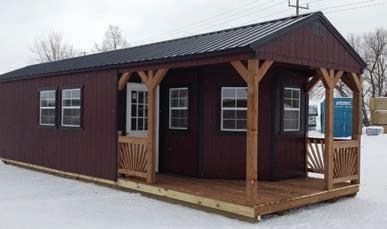
“When I’m working in the tractor and I have these two (points to his daughters) in there with me sleeping, I remember doing that as a kid. We did that a lot growing up,” Tim said.


The late Maya Angelou, a renowned American poet and civil rights activist, once said, “If you don’t know where you’ve come from, you don’t know where you’re going.”
The same can be said for forecasting the weather.
David Phillips, a senior climatologist with Environment Canada, says that while winter conditions will not guarantee what spring will look like, they can provide an idea of what is in store.
“I always think there is no connection between one season and the next season. That is generally true –spring doesn’t tell you what summer is going to be like, and winter doesn’t tell you what spring is going to be like,” he said. “The only connection is if you have a hard winter, then spring is a little slower to come because you’ve got to get rid of the winter look and feel before you can expect the ground to soften up and the smells of spring to come.”
Added Phillips, “Mother Nature has its own personality and character and will do what it wants to do and we just try to guess what it is going to give us. I think it is important in interpreting what we see going ahead by what you have right now.”
Phillips said the fall, particularly September, provided plenty of rain – about twice the September average – to replenish soil levels in midwestern Ontario.
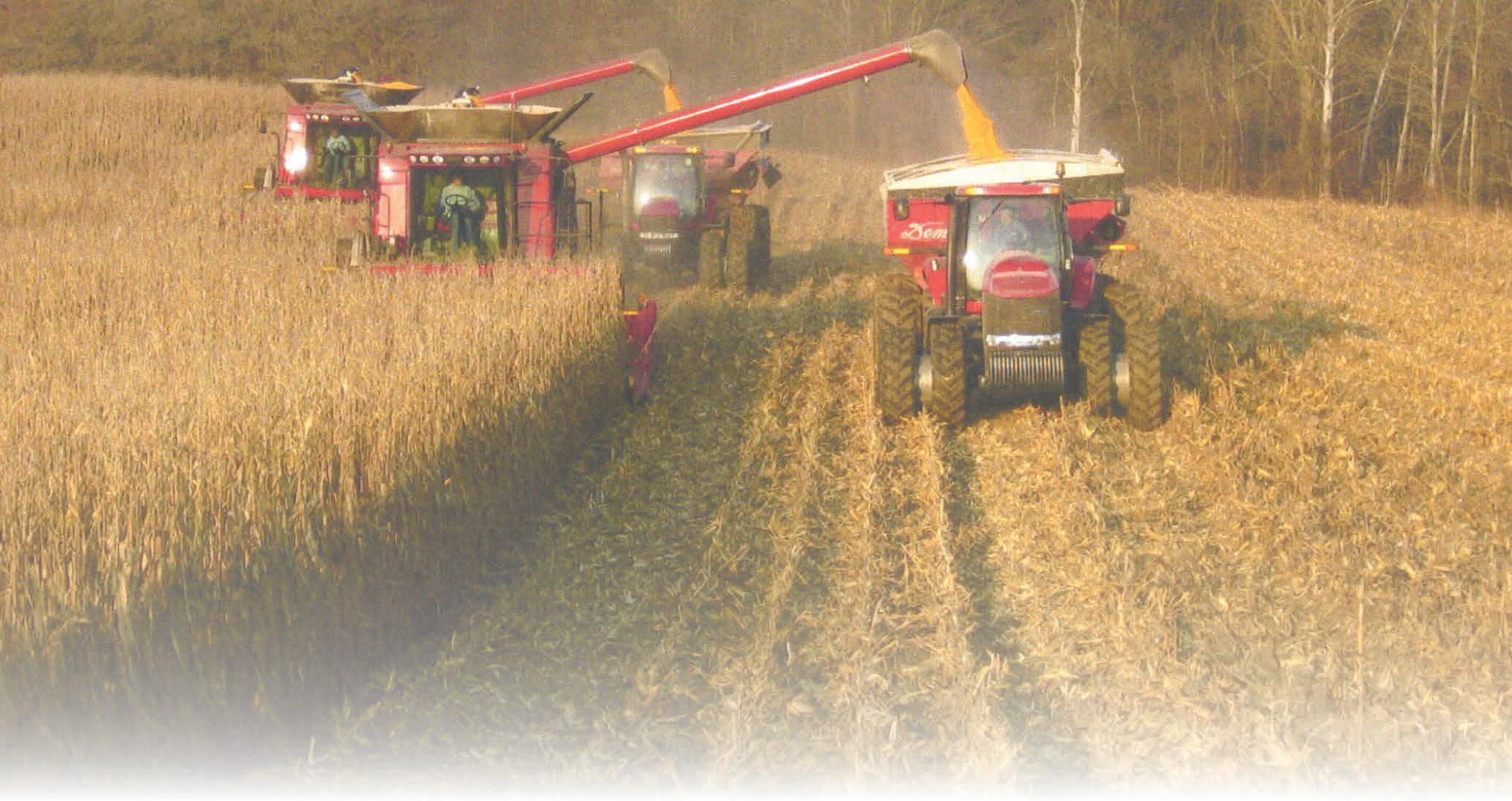
“I think that water may have hurt harvesting at the end, but it got the moisture into the rivers and creeks, and the soil moisture was well-replenished,” said Phillips.
“There was some very adequate moisture there to remove any deficit that had occurred. I think there was some very promising news from that point of view.”
According to Phillips, the current amount of snowfall in our region is about two-thirds of normal amounts.
“The amount of precipitation since January has been down a bit,” he said.
He describes the weather since September to be “very
close to normal.”
“What could be better for a farmer?” he asked. “Normal is what they live for. They don’t want it to be really hot and really cold, they want normal. That’s what you’re all set up for – your strategies, policies, decisions are all based on normal.”
commented.
While the weather is warming up slightly, Phillips warns it is too early to put away the snowblower and shovel.
“We still have a long way to go. Anything we get now in terms of temperatures that seem mild or springlike, it’s false spring,” he said. “You can’t always get out in your fields in March, and we all know April can be the cruel month, so overall when you look at snowfall in your region, about 27 per cent of your annual snowfall occurs after Feb. 13.
“Don’t write the final chapter on winter quite yet.”
As far as spring is concerned, Phillips says Environment Canada’s models predict a warmer-than-normal spring for southern Ontario.

“But it’s not July warmth, it’s warmer than seasonal temperatures. Most of Canada is showing colder than normal,” he said.
Phillips believes spring will be “slow but persistent” in arriving due to the frozen ground from January’s temperatures and the lack of “January thaw.”
- David Phillips, Senior Climatologist Environment CanadaTemperature-wise, winter began in January, said Phillips, when the colder-than-usual temperatures rolled in and the snow began to fall.
“You had more than twice the number of cold days (-20), but prior to that it wasn’t very difficult at all. December was almost four degrees warmer than normal, and November as kind of near normal. October was one of the warmest months we have ever seen – four degrees warmer than normal,” he explained.
We also didn’t experience the usual “January thaw,” said Phillips.
“All of the snow that came, which wasn’t a lot, remained. I think that cover for growing is good,” he
“It looks like things will begin to warm up and we’re going to see above normal precipitation through the spring,” he said. “My sense is this is probably as good as farmers can hope for – the gradual loss of winter and sure, steady arrival of spring.”
In terms of looking ahead at the summer, Phillips was hesitant to put much stock into forecasts that far in advance.
“This this is almost science fiction to look that far in advance, but both the Canadian and American models are saying the same thing: a warmer-than-normal summer and wetter,” said Phillips.
That, he says, is music to growers’ ears.
“Warmer doesn’t help if you got drier. But if you got warmer and wetter, oh my gosh, that’s a utopia for gardeners and farmers,” he said. “It could be a bumper year if you have that forecast.
“I wouldn’t want to bet more than a loonie or two on that, but that’s what the models are saying right now.”
“This is almost science fiction to look that far in advance, but both the Canadian and American models are saying the same thing: a warmer-than-normal summer and wetter.”

 LILIAN SCHAER FARM & FOOD CARE ONTARIO
LILIAN SCHAER FARM & FOOD CARE ONTARIO
Lake Erie is famous for its fishing and sand beaches, but it has also become known for its summer algae blooms. And although there are many urban and rural sources for the nutrients going into the lake, agriculture is often an easy target when people are looking to lay blame.
That’s because farmers’ nutrient management activities are highly visible –especially hauling and spreading brown manure across a white winter landscape. Manure is important for healthy soil and to grow good quality crops, but how and when it is applied can have bad effects on the environment, and cost farmers money in the process.
For example, solid or liquid manure should not be spread on frozen or snowcovered ground in the late winter if at all possible. Water takes the path of least resistance and when the ground is frozen, any manure on the surface is easily washed away during winter rains or when the snow melts. Even with solid manure, a little bit of rain will leave only the straw behind on the field.

From there, manure ends up in streams, rivers and lakes, where it pollutes the water, kills fish and helps promote algae growth, like in Lake Erie.
New research has proven that most of the phosphorus that runs off from Ontario fields does so in the fall and winter, and most often during or after big rains and spring thaws.
Here are three other reasons why ma-
Winter rain and snow melt wash away manure on frozen ground. Nutrient run-off helps pollute the water, kill fish and promote algae growth. Manure is valuable and those are dollars wasted when it’s washed away. Winter spreading doesn’t stop compaction.
nure should not be spread on frozen or snow-covered ground:
Manure is valuable, and if it runs off, those are dollars wasted
Livestock manure is a valuable replacement for expensive commercial fertilizer. When that manure is washed away
instead of going into the ground, it can no longer be used by the crop that will be in that field in the next growing season. That means those nutrients are lost, so they must be replaced to have a productive crop.
See Spreading on page 25
Know how much manure storage you have. Be prepared in case fall spreading isn’t possible.

Cover or expand your existing manure storage. Temporary in-field storage can be a solution for solid manure.
Add winter wheat or cover crops to your rotation for extra manure spreading opportunities throughout the year.
For more information:

Timing Matters
519 837 1326
www.FarmFoodCareON.org/Timing-Matters











In four short years, Home Grown Food Basket has expanded from a home-based business to a storefront in Wingham, and now to a secondary headquarters located in the former Fordwich United Church. But that’s not all of it for this company. Owners David Sherpenzeel and Jef MacPherson have recently purchased a plot of land in Nova Scotia with plans of expanding their business out of province in the future.
Home Grown Food Basket is a local food store in Wingham, featuring locally grown and sourced products including fruits and vegetables, meats, cheeses, baked goods, and preserves to name a few.
The company works with local vendors to provide a full grocery store experience, both in-store and online, with all the products sourced from southwestern Ontario.
Home Grown Food Basket is moving the production and distribution side of their business into the former Fordwich United Church. The church, built in 1902, was a place where the community gathered for close to 96 years.
For Sherpenzeel the building has a special sentimental value. Although he did not regularly attend church at the former United Church, he has many fond memories of strawberry dinners, community programs, and attending family weddings.
“The day my dad proposed to my mom was Valentine’s Day and he brought her here to the Valentine’s Day church dinner,” he said. “Although he didn’t end up proposing here. They went back to the farm, got changed into their barn clothes and Dad proposed in the kitchen on their way out to do chores.
“I grew up in Howick and I have lived in Howick most of my life, so for me to be able to bring something to the community that will have a positive impact and can preserve a building that means so much to this community is really exciting.”
MacPherson is equally excited about their new headquar-
ters. “At Home Grown we do a lot of work with agriculture and just being able to stay in the rural community of Fordwich and keep the business in the rural area where it is able to support a rural community, but also be close to the roots of agriculture is really important and exciting for us,” he said. The roughly 4,000 square foot building is more than enough space for Home Grown Food Basket right now, however, the company plans to grow into the building.
Sherpenzeel and MacPherson plan on getting the kitchen and adjacent dining space cleaned up and outfitted to be used as their food production and distribution space in the next few months. This expansion will allow the company to also expand its line of soups, partially prepared produce and frozen dinners. The rest of the building, like the sanctuary and office spaces, won’t be immediately renovated. They are planning to renovate spaces as the company grows and requires additional space.
“That is what is nice about this building, we don’t have to do it all at once,” Sherpenzeel said. He added that as they move the production part of their company into the church, it will allow them to expand their store in Wingham.

“The nice thing about the Wingham store is that as we move everything here it will open up enough space in the store that we can increase our retail space by 33 per cent,” Sherpenzeel said. “The back third of the store is where we process orders and put together the baskets, but if we don’t need that space, we can use it for store space.”
At the moment, there is no plan for the Fordwich headquarters to have a traditional store, however they have plans to allow customers to place and pick up orders in Fordwich.
“Once we have this place operational, there will be online ordering available with pickup available in Fordwich,” Sherpenzeel said. “If there is someone who doesn’t want to order online there will be a re-
ception space where they can wait while their order is packaged. We know we have some customers who might not be comfortable doing online ordering – they can still come here and place their order.”
The company works with over 35 local vendors and it is estimated that Home Grown Food Basket supports between 200-300 farming families.
They have a ratio of between 60-70 per cent returning customers, and 30-40 per cent new customers every month.
“Our December sales were two or three average month’s sales, which is great because it is also giving our vendors and successful Christmas time,” Sherpenzeel said.
The benefit of selling with Home Grown as opposed to selling to a traditional grocery store is that Home Grown shares a higher margin of sales (as high as 70 per cent, depending on the product) and their vendors get to continue to be the face of their brand.
“We champion them for what they do,” MacPherson said.
“Basically, what we say to our vendors is you set your price, it is then our job to mark it up to something that is sellable and to do the marketing to make sure it moves. But they need to make enough to cover their costs and to be comfortable.”
Sherpenzeel added. “That is why we give them higher margins. It does mean we operate off of smaller margins at times, but so far we have been doing OK with that. It just involves some planning ahead.”
Home Grown Food Basket carries a variety of food items available for in-store pick-up or delivery.
“We do nationwide shipping for non-perishable and delivery of perishable items within 100 kilometres,” Sherpenzeel said.
Home Grown Food Basket services include:
- A subscription basket, where every month, week, or every other week customers receive a customized basket including produce, meat, baked goods, eggs, cheese, and preserves.
- Fundraiser baskets filled with local goods, with the of-
ferings changing on a monthly basis. The fundraiser baskets are available January-November.
- Bulk ordering of local goods to provide for a caterer, restaurant, or local canning projects.
- A variety of gift baskets are available throughout the year, they also do corporate gift baskets, both change with the seasons.
- Helping Hands program allows customers to donate a basket of local goods to a family in need. By making a donation to Home Grown Food Basket a basket will be directed to a local food bank. Baskets are also available to order and deliver to a specific family in need.
- In their store, Home Grown Food Basket has many local goods for purchase including chicken, turkey, beef, eggs, produce, soups, frozen meals, and partially prepared produce.
“Everything we produce in our kitchen will be co-branded with whatever products are featured in it,” Sherpenzeel said. “You will know exactly which farms everything is coming from.”
expansion out east Sherpenzeel and MacPherson have recently purchased a 86acre plot of land in Caribou River, Nova Scotia.
“It is a nice spot, it is a former farm but it hasn’t been farmed in 50 or 60 years,” MacPherson explained. “There are a couple cleared fields, pasture, and bush.”
Their plan for this expansion is to begin with a small store where they can sell locally grown produce, livestock, and cabins for an agri-tourism farm experience for travelers.
“Our dream is to have Home Grown spread across the province, country, and world maybe in different ways or aspects but always with the purpose of making an impact on agriculture wherever we go,” Sherpenzeel said.
***
To order from, or become a supplier to the Home Grown Food Basket visit their website www. homegrownfoodbasket.com.


Continued from page 2 went together really quick,” he said.
The system uses transmitter tags on the cows to communicate to the milking machines. These tags send data to a computer system, which tracks the milking data of each cow in the barn. It also monitors when the cow was last milked, ensuring the cow is milked only at the appropriate times.

The system also alerts Andriessen when there may be an issue with a cow.
“It’ll send a message to my phone with the details, then one of us can come down to
the barn and look after it,” he said.
This useful information, Andriessen says, helps with vet bills as issues can be caught before they become too severe.
The new system has also made things more efficient in the barn. Andriessen said milking in the parlour was about a 90-minute job, and now with the robotic milking system they can work on other chores simultaneously.
“It’s been a big change,” he said. “It took some getting used to for us and the cows, but so far everything has worked well.”








Monday-Friday
(GRIP) is a new 10-episode podcast series exploring innovations in the Ontario agriculture sector. It was developed by Livestock Research Innovation Corporation (LRIC) in partnership with the University of Guelph (U of G) and the Poultry Industry Council (PIC).
“We wanted to highlight what makes a successful innovation and identify what barriers keep some ideas from ever making it to industry or farms,” says Dr. Jennifer Ellis, assistant professor in the animal biosciences department at the University of Guelph.
The focus of the GRIP podcast series is on researchers and industry professionals in different animal agriculture sectors who have successfully applied research and innovations in their field. The collaborating organizations came together to develop this podcast with the shared goal of cultivating and encouraging innovation and research for the future of the provincial livestock sector.
“Innovation is most successful when industry and academia work together, and so we need to bridge the innovations being developed and people at the farm level who decide which to adopt,” says Ashley Honsberger, executive director with PIC.
With the fast-paced nature of the agriculture industry, it is critical that researchers not lose sight of the changing
needs and challenges of the industry. Producers must also be proactive by raising issues and questions and then considering options and taking action at the farm level.
“Innovation is all about change and change is all about people and so we need to listen and connect people and ideas toward better innovation,” says LRIC CEO Mike McMorris.
This podcast series, funded and supported by Mitacs through the Business Strategy Internship (BSI), and the Ontario Ministry of Agriculture, Food and Rural Affairs (OMAFRA) through the Knowledge Translation and Transfer program, aims to help identify ways to help bridge the gap and lead to more interaction and innovation. You can listen on Thursday mornings to the GRIP podcast on Apple Podcasts, Spotify and Anchor FM.
Established in 2012 with support from Ontario’s beef, pork, dairy and poultry sector organizations, and OMAFRA, LRIC’s mission is driving innovation. The organization takes a value chain approach to research and innovation by providing leadership in research priority setting, coordination and process, identifying and communicating emerging issues, and strengthening networks across the sector.
For more information, visit www.livestockresearch.ca

‘Getting Research into Practice’ podcast examines what makes a successful livestock innovation “





Hybrid in-person, virtual events tentatively on the slate for 166th event, July 14-17

 DAN MCNEE
DAN MCNEE
Since the onset of the COVID-19 pandemic two years ago, businesses, families and individuals have had to rapidly adapt to an ever-evolving situation in the interest of public health. Service organizations were, of course, not excluded from the hardships faced, and with the growing hope that the summer of 2022 will have some semblance of pre-pandemic normalcy, the Listowel Agricultural Society (LAS) is planning to welcome back the North Perth community and beyond to its most antici-
pated annual event.

As it stands this spring, the LAS has put plans in motion to host the 166th edition of the Listowel Agricultural Fair in a more traditional format, whereby inperson events will once again return to the fairgrounds come July 14-17. Planning for an event of this size is no easy feat, but the LAS board of directors’ 25 members have been busy since the fall of last year tentatively assembling a schedule that resembles more of what visitors came to expect of the fair prior to 2020.


See 166TH on page 16












Continued from page 14
“We are looking forward to returning to what the Listowel Fair used to look like, but also with some new additions and some changes,” commented LAS President Elizabeth Johnston. “We know it won’t look exactly the same; we will still be working with Huron Perth Public Health to make sure that we’re following all the regulations that are in place. At the very least, we hope that most of our events will be able to make their return, especially the outdoor ones. Maybe we’ll be able to have all of our events return to the fair this year.”
Attractions like tractor pulls, livestock shows, the demolition derby and coordinating a midway require extensive advance planning, with the added wrinkle of abiding by public health regulations that have now become standard in the pandemic era to ensure the safety of those who plan on attending in person.


“We want people to feel comfortable coming back to the Listowel Fair,” said Johnston. “It’s been three years since we’ve been able to welcome people to the fairgrounds.”
The last two Listowel fairs have looked markedly different, with the LAS required to come up with some outsidethe-box virtual aspects to ensure that the event continued on in some capacity. The everpopular home craft exhibition continued on virtually, while
the addition of a communitywide scavenger hunt over a two-week period in 2021 was a well-received event that will return in 2022, among others.
“COVID has changed the way we look at a few things,” affirmed Johnston. “Some of our home craft competitions will still be held in a virtual format; people can compete whether they want to in-person or virtual, we have both of those options that are going to happen this year for some of our competitions.”
When asked about the strength of the LAS in terms of finances and general morale of its board, Johnston said that the organization has held up well over the last two years despite not being able to host a full-scale fair in 2020 and 2021. Loss of revenue from events such as buck and doe receptions hosted at the Listowel Agricultural Hall also understandably hurt the organization’s finances.

Johnston added that virtual components would remain a part of the 2022 fair as a whole; for example those dedicated home craft exhibitors not yet comfortable with returning for in-person showings will still be able to submit entries via online means. With the progression of digital technology, competitions such as the photography category make more sense to take place entirely virtually.

The LAS expects to release the advance prize list for the home craft competition this spring.
The Listowel Fair is the Ag. Society’s primary fundraiser, and with its cancellation the last two years a number of drivethrough dinner events and additional revenue from other initiatives helped to supplement income. Provincial government funding through OMAFRA grants also assisted the organization.

“It’s been a bit of a challenge to keep everybody excited in what we’re doing,” said Johnston. “But our fair board I’ve found has been very resilient throughout COVID, and they are want to make sure that the desire and the passion keeps
See PLANS on page 24

“At the very least, we hope that most of our events will be able to make their return, especially the outdoor ones. Maybe we’ll be able to have all of our events return to the fair this year.”
- Elizabeth Johnston LAS President



SLOW SPEED CYCLO CONTROL FEATURES




Soft starting eliminates electrical and mechanical shock to motor and drive system and provides superior performance compared to across-the-line starting. Extends life of elevator components and allows elevator to continue to achieve its rated capacity. Benshaw patented built-in slow speed CYCLO control allows the selection of a slower speed to perform bucket elevator maintenance inspections without changing motors and pulleys. Operator can check for damage to belts, splices and buckets. Allows for regular maintenance inspections and reduces unscheduled downtime. Increases productivity and reliability of system.

Contact Benshaw Canada to discuss your motor control needs. 550 Bright Street East | Listowel, Ontario Toll Free: 1-877-291-5112 | Phone: 519-291-5112 | Fax: 519-291-2595 www.benshaw.com or www.benshawexpress.ca





Followed by an energetic dog by the name of Trigger, Amanda and Shane Stege walk between conifer trees, peeling back their needly, overlapping branches.
Beyond the evergreen curtain stands a herd of hefty bison – also called buffalo – their breath cloudy in the December air.
The bison belong to the Steges, who own and operate Northwind Bison on their Mapleton farm property.

Raising North America’s largest land mammal is a rare form of agriculture, not only in Wellington County, but the province at large with around 30 bison operations registered with the Ontario Bison Association and 49 Ontario farms reporting bison in a 2016 Canadian Bison Association census.
Standing upwards of six feet tall and





weighing nearly a tonne (2,000 pounds) when fully grown, Northwind’s bison are visible from Concession Road 8. But it’s another thing altogether to be up close.
The Steges toss the herd sliced apples that might as well be peace offerings. Moving cautiously around the wildminded animals as they keep a watchful eye, the Steges know the gentle giants could, in a matter of a second, charge and close the few feet between them.
The Steges separately grew up in farming families but hadn’t felt what Amanda called a “burning desire” to farm.
Shane became a tool machinist and Amanda a dental hygienist. But those born into agriculture have it in their blood, Amanda said, and the couple soon enough felt a desire to return to their roots.
Living in Drayton and working in their respective trades, Shane at Norwell


Dairy and Amanda at Palmerston Dental, the conversations about getting into farming began cropping up.
“I was used to the country, loved the country life, you’re out in the open more, you’re not surrounded by people,” Shane said.
In 2012, the couple made their foray with an already-established poultry operation run by Amanda’s father, John Ottens, under the Snetto Farms banner.



Three years later, in 2015, the Steges took over the poultry operation, purchasing the 100-acre farm from Amanda’s family.
“He came home and said, ‘You know what would be neat? To get into bison,’ and I told him, ‘You’re crazy,’” Amanda said.
“It was one of those things that we
kind of mentioned and talked about and laughed about… but it’s something I just couldn’t [let go],” Shane said. Amanda was drawn by bison meats’ nutrient makeup: a lean red meat, low in cholesterol, and saturated fat, and still providing much of the nutrient value found in similar red meats, like that of beef cattle.
Following a meeting with the Ontario Bison Association in 2018, the couple were “hooked.”

Two pasture lots were fenced off and the Steges purchased their first four female and two male bison from a Waterford-area breeder the following year.
“We would go sit out there and just watch them, it was kind of relaxing to come home to and go feed ‘em and bale
Continued on page 19

Continued from page 18
‘em and just sit there and watch them for 20 minutes – they’re addicting, I guess you could say,” Shane explained of his fascination with the animals.
“They could be such a powerful animal at any moment but when you see them in the field, they’re calm, they’re peaceful.”
“When they do get close, it’s almost like a hold-your-breath moment,” Amanda remarked.
“You feel that power while you’re there,” said Shane.
The herd now stands at 21 strong, grazing 35 acres of pasture land across three lots (each bison requires a single acre of pasture land for grazing).
One of the top questions the couple gets is why bison don’t have barns.
“These are some of the happiest days they have, where it’s cold,” Shane explained.
“They’re the same as they were a hundred years ago.”
Seeing bison coated in snow isn’t a bad thing either, he said.


It means the animals’ thick coat is doing its job of insulating. If it wasn’t, the snow would melt from the bison’s escaping body heat.
The bovines are low-maintenance and independent. Compared to similar red meat animals, like beef cattle, the bison only require space, pasture, dried hay, water and a molasses “mineral lick” to be content.
Otherwise, they’re left to roam, breed and calve on their own, and bring few health concerns.
The Steges said a vet has only made a visit to the farm once in the past three years.
Because bison require little human intervention and live naturally on the land, the species
lends itself well to conversations around animal husbandry and regenerative agriculture practises.
“As the younger generations are coming up, they question things more, they want to know: ‘Where does my food come from?’” Shane said, adding the best farm policy is openness and transparency.
Amanda said, as farmers, it’s “wise to acknowledge those conversations and not pretend that they’re not happening” and said there’s plenty of room for both conventional and modern agricultural practices, pointing out that Northwind is a happy combination of both, with larger poultry and niche bison production.

“I’ve always been in the mind
to people just looking to try something different.
“There’s more talk about bison, there’s more, I guess you could say ‘hype’ about it,” Shane said.
Amanda called the small bison market a “build-your-own-
market industry.”
They’ve had inquiries from local restaurants wanting to add bison to their menu but are still growing their herd to respond to the interest the farm has generated.
“It’s a patient business,”
Amanda said.
The couple continues to work full-time jobs off the farm, while farming evenings and weekends.
Farming full-time, Shane said, would be more realistic as an early-retirement dream once their three children – aged five, eight and 10 – have grown.
Amanda believes it’s almost necessary for younger farmers to have an off-farm income these days. Although the farm income sustains the farm itself, it doesn’t cover the cost of living, she explained.
“To live, we need to work,”
she remarked. And when the work is finally done, Amanda and Shane can be found peering in admiration at their growing herd.
Nearly rendered extinct over 100 years ago, they now range through the Steges’ backyard as though a 19th century painting of the Great Plains were brought to life.

frame of ‘I love growing things’ – I love growing birds, I love growing the bison,” Shane said of his passion for raising both animals and providing quality meat.
At around 1,100 pounds, bison reach market weight and yield upwards of 400 pounds in cuts.
Northwind’s customers range from the health-conscious,





- Shane StegeJordan Snobelen Photos Shane Stege holds a patch of fur shed from a bison’s shaggy coat. A herd of bison at Northwind Bison in Mapleton.
Jill Lewis has a vision.
Lewis, co-founder of the Huron Perth Ag Science Centre, envisions providing a place in Huron and Perth counties where people of all ages can learn and explore the world of STEAM (science, technology, engineering, arts/agriculture and mathematics) in a fun, handson environment.
The Huron Perth Ag Science Centre will, as the name states, be focused on agriculture and science, and located somewhere in Listowel.
Lewis’ initial idea was to bring a children’s museum to North Perth following a family trip to Chicago, where she
visited the Chicago Children’s Museum. “I had never been to a children’s museum before, had no idea what it was going to be about – I pictured, in my head, a traditional museum with exhibits on the wall, lots of reading and learning and history,” she recalled. “In fact, a children’s museum is all play-based, interactive, fun exhibits. It was amazing. I could see how all sorts of kids would learn in this environment where they were directing the play, they got to choose how long they were playing in each exhibit.”
Lewis explained the kids could visit a fire truck exhibit, for example, and play with the equipment and get a hands-on experience.

J-K
• Barn Painting

• Sandblasting
• Hot Water Pressure Washing

• Epoxy Coatings

Jeff Kunkel (519) 343-3737





Jeff@jkindustrialpainting.com

SPECIALIZING IN:
• Farm Drainage
• Municipal Drainage
• Backhoe Work
• Land clearing (fence lines, bush lines)
• Excavator Work
• Dozer Work

• Erosion Control
WE OFFER:
• Over 50 years of experience in providing the best drainage designs

• Contour plans of the project from a field survey
• Professionally designed drainage systems from the contour plans
• State of the art equipment
• Qualified and experience personnel
• Guaranteed workmanship & customer service
• All this at the most economical cost with very competitive pricing For that personal touch, pride in workmanship, most efficient, effective & economical drainage systems, call the professionals for a free estimate.
“It was a fun way for kids to learn the safety messaging and learn about different topics in a non-frightening way,” said Lewis.
After returning home to Perth County and sharing details of her experience to friends and family, the common response was, ‘Wow, we’ll have to go to Chicago sometime.’
“I know that’s not realistic for every family, so I got wondering how we could bring something like that here, where it is play-based, for the kids, educational – some third space for kids outside of the home and school where they could feel it was their own, and a space for kids who maybe aren’t interested in sports but would like to focus on technology or engineering or agriculture,” said Lewis.
Lewis formed a steering committee, which approached the Municipality of North Perth with the idea. North Perth council was receptive to the idea, and supported the committee in applying for an Ontario Trillium Foundation grant to conduct a feasibility study.
That study, completed by Lord Cultural Resources in 2020, provided the committee with a “more concrete direction” and recommended the focus be changed from a children’s museum concept to a science centre concept.
“Only because it actually broadens your audience,” said Lewis. “The children’s museums now, the age focus
is generally up to age eight or nine, so that’s why the science centre will be appealing to people of a wider age range.
“It will be appealing to people of all ages, but there will be different spaces. We do hope to have a space for smaller, younger kids, like a ‘Kids Zone’ play area, but also engaging educational activities and exhibits for people of all ages.”
Lewis said it will also be the first centre of its kind in Canada, focusing on agriculture and science, and expects the centre will be open year-round.
“We’re hoping to incorporate co-ops for high schools so students with all sorts of different interests could run programs for youth and be able to volunteer or even get jobs,” said Lewis. “It will employ people but also provide meaningful volunteer opportunities in the community.”
Some of the exhibit ideas which the board has already discussed are: Agriculture Through the Ages, Climate Change and Agriculture, Agriculture Safety, Agriculture Technology, Agriculture Innovation, On-farm Biodiversity, Sustainable Farming, Soil and Land, Maitland River Conservation, Careers in Agriculture, Indigenous Agriculture, Agriculture and Art, Farm Dress Up and Costumes, Farm to Table Cooking, Environmental Agriculture, Healthy Habits and Nutrition, Nature Stewardship, and Mental Health in Agriculture.
Lewis sees the Huron Perth Ag Science Centre as a destination for school field trips, outings for groups such as 4-H, local agricultural socieities, Big Brothers Big Sisters, and Community Living, to name a few.
See HURON page 22
our community will be proud of’ Board hopes $13.8M, 20,000-square foot facility to open in Listowel

Continued from page 20
The committee presented the results of the feasibility study to the Municipality of North Perth, which voted in favour of donating land for the proposed centre if the committee is successful in its capital funding campaign.
No specific plot of land was designated by the municipality for the proposed centre, but Lewis has a site in mind.
“There is some land on Binning Street West across from the Steve Kerr Memorial Complex and the North Perth Westfield Elementary School that I think would be a perfect location,” she said. That piece of land is close to two major highways – Highway 23 and Highway 86 – and is in an area already known for kids. It is also close to food and retail.
“What a great team building activity (the centre) would be for teams during a break in a hockey tournament,” she said.
Last fall, the Huron Perth Ag Science Centre put a call out for volunteers to join its board of directors. Lewis says that several people came forward, and the board has been put together. The board is made up of 14 individuals with various experience and skill sets, including one member who has experience operating a science centre. Other board members have experience in science, agriculture, development, hospitality, not-for-profits, business, administration and education.
“We have people with a ton of different backgrounds and experiences,” said Lewis. “I’m very thrilled with our board and all of the very qualified people that are on it.”
Now that a board of directors is in place, the group is working on obtaining its charity status while working behind the scenes in planning the capital fundraising campaign.
Lewis said there is much to be done,
as the project (as of the 2020 feasibility study) has a price tag of $13.8 million for the proposed 20,000 square foot building. That price includes the building and its contents, including exhibits.
Although the price tag is high, Lewis is confident that the Huron Perth Ag Science Centre will open in the near future.


“I cannot believe the support we have received from everyone,” said Lewis. “North Perth council, Perth County council, Huron County council – everyone I have talked to in the community has been so supportive and they love the idea, love what it could bring to our community.

“It will not only be a tourist destination, but also something our community can be really proud of and highlights all of the great things that already exist within our community.”
Lewis also noted the Ag Science Centre will be yet another reason for young people and young families to stay in the area.
In addition to the words of support from various community members, Lewis said several have asked how they can help and get involved.
“It really is motivating for us when we hit speed bumps, but to know the community is really excited about it too gives us more motivation to keep moving forward,” she said.
Those interested in helping and supporting the Huron Perth Ag Science Centre are encouraged to visit huronperthagsciencecentre.com and click on the “How To Get Involved” tab.


“When the time comes, we will reach out to people and let them know how they can help,” said Lewis.
The Huron Perth Ag Science Centre also has a social media presence. It can be found on Facebook and Instagram –@HuronPerthAgScienceCentre.

Researchers at the University of Manitoba, working in collaboration with the Ontario Cover Crop Steering Committee, have shared the results from the 2020 Ontario Cover Crop Feedback Survey, the largest survey of its kind in Canada based on the number of responses received. The survey captured a snapshot of grower observations from incorporating cover crops into their practice.
Cover crop use in Ontario has a long history. The practice has increased in recent years. The Ontario Cover Crop Action Strategy, created in partnership with the Ontario Agricultural Soil Health and Conservation Strategy, has set new goals to facilitate widespread adoption of cover crops in Ontario.
Of the 520 respondents that grew cover crops in 2020, 91 per cent observed benefits from growing cover crops. The observations include:
• 68 per cent of farms saw improved soil health;
• 59 per cent observed less soil erosion; and


• 57 per cent reported seeing increased soil organic matter.




More than three quarters of farms reported benefits within three years of adopting cover crops.
“Ontario continues to innovate in farming practices that benefit the environment and adopt cover cropping as one strategy. We know that to continue to build on these successes and continue to help Ontario and Canada meet climate change goals, farmers will need support for these practices to help overcome the barriers that farmers face in their implementation,” said Marty Vermey, senior agronomist at Grain Farmers of Ontario and chair of the Ontario Cover Crop Working Group.
The study showed some challenges in adopting cover crops. The most com-
mon challenges included poor cover crop establishment, the late harvest of a cash crop preventing cover crop planting, and the additional costs associated with growing a cover crop.
Although the expansion of cover crop adoption in the province is an indication of the benefits that some farms experience with this practice, barriers that hinder widespread cover crop adoption still exist. This makes it an important time to hear from Ontario farms about the benefits and challenges they experience, their needs for research and knowledge transfer, and to get feedback on what could enable wider adoption of cover crops in Ontario.
“It is an important time to hear from farmers about their needs for research and knowledge transfer,” said Callum Morrison, graduate student and report author, University of Manitoba.
The 2020 Ontario Cover Crop Feedback project was developed to provide information to farmers, agronomists, researchers, policy makers, and government organizations that will play an important role in the future of cover crops in Ontario.
The project was a voluntary online survey of Ontario farms, targeting both farms that did and did not grow cover crops during the 2020 growing season. Farms of all types and sizes in Ontario were invited to take part. A variety of questions were asked to farmers who grew and did not grow cover crops. Both groups were asked about farm characteristics, motivations, what would enable cover crop use, and where farms source information.
“Ontario‘s Certified Crop Advisors are pleased to have participated in the survey recruitment and review processes of the Cover Crop Report,” said Ken Currah, certified crop advisor and Ontario Cover Crop Working Group

member. “We look forward to working with our farmer customers to transfer this knowledge and providing our advisory services in support of their farm management decisions around soil health improvement, environmental stewardship, and continued cover crop adoption.”
In total, the survey collected responses from 731 farmers, 520 of which grew a cover crop in 2020 and 211 did not grow a cover crop that year.
“This survey was made possible by the great support of Ontario farmers. They were asked to provide their feed-






back about what was occurring with cover crops and the response was tremendous,” said Paul Hoekstra, vicepresident of strategic development, Grain Farmers of Ontario. “We thank the farmers, researchers, and the Ontario Cover Crop Steering Committee for the incredible work they have done to represent the needs and voices of Ontario‘s grain farmers to highlight the areas where we can continue to provide the best support.”
The report can be accessed at bit. ly/323V2w4.



Continued from page 16 up so that the Ag. Society is still here when COVID is over, or at least when we’re coming out of COVID. The enthusiasm is definitely there.”
Johnston added that the community’s support of the LAS throughout the pandemic has been the true difference maker in allowing it to sustain.

“We’ve held our own throughout this,” she said. “We are very fortunate as an Ag. So-

“We are very fortunate as an Ag. Society to be in the community that we’re in.”
 - Elizabeth Johnston LAS President
- Elizabeth Johnston LAS President
ciety to be in the community that we’re in. We have received some great community sup-
port. It’s heart warming to see that people are concerned about the Ag. Society, and hope that we are doing OK, and that we will be around to host future Listowel fairs, and all the other events that happen throughout the year. “I think that’s a testament to rural communities.”
For ongoing updates pertaining to the 2022 Listowel Agricultural Fair, visit www.listowelfair.com






Continued from page 8
Some farmers believe that spreading in the winter when the ground is frozen reduces the potential for soil compaction by heavy manure spreaders or liquid tankers. That’s not actually the case, because although the soil’s top layers are frozen, the ground underneath is not and will still suffer the impacts of compaction.






The public eye is focused on farmers more strongly now than ever before. Manure spreading in the winter can attract unwanted attention and make farmers an easy target – even though there are many contributors to the phosphorus problem.
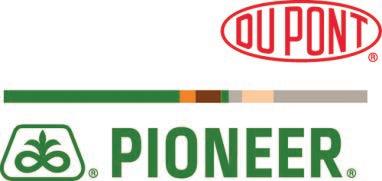
Most Ontario farmers are actively taking steps to avoid winter spreading.


Those most likely to spread manure in the winter don’t have enough manure storage on the farm, or were unable to empty liquid manure tanks before the ground froze because of wet fall weath-

er.
There is no single practice that will address all issues or serve as a solution on every farm, but here are some key ideas:
- Plan ahead: know how much manure storage you have and be prepared in case spreading in the fall isn’t possible.
- Expand storage: Cover or expand your existing on-farm manure storage. Temporary in-field storage can be a solution for solid manure.
- Change your crop rotation: add winter wheat or cover crops to your rotation for extra manure spreading opportunities throughout the year.

More information about manure stewardship and long-term nutrient management options is available at https:// www.farmfoodcareon.org/timing-matters/.
This article is provided by Farm & Food Care Ontario as part of the Timing Matters project. The project is funded by the Ontario Ministry of Agriculture, Food and Rural Affairs.
Maple Syrup products available all year-round. Help us celebrate Maple Weekend, the first weekend in April. We are offering tours which include the bush and our facility. Check out our website to book your tour.
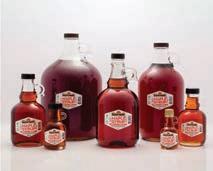
We have something new coming May 2022. Introducing Hoover’s Maple experience. Check out the details on our website. Participants have raved about this ‘sweet’ experience.

If you would like a tour of our facility outside of Maple Weekend, March is Maple Month at Hoover’s so we’d be happy to show you around. Check out our website to book a tour.
Remember Maple Syrup is an ingredient, not just a topping - check out our maple cookbook to try new healthy meals and some sweet treats.
We produce Certified Organic, Award winning Maple Syrup.













 MIKE WILSON
MIKE WILSON

The dates for the 2022 Huron County Plowing Match have been announced.
This year’s event will take place Aug. 18 and 19 at the farm of Brian and Annette MacKenzie, located at 85399 St. Helen’s Line in Ashfield-ColborneWawanosh.




Huron County Warden Glen McNeil will act as co-host of the event.
The Huron County Plowmen’s Association plans on hosting its regular twoday event. The 2021 event was a modified one-day affair.

Thursday, Aug. 18 will feature the Junior/4-H practice in the morning, with the junior plowing competition and 4-H Sodbusters achievement in the afternoon. The Princess of the Furrow competition will also take place on Aug. 18, with current Princess Grace Hallahan assisting with the program.

Friday, Aug. 19 will feature various


plowing competitions, with plow people from Huron County and neighbouring areas competing. Visitors to the match will also be able to attend numerous displays and participate in a silent auction. The Queen of the Furrow competition will also take place, with reigning Queen Maranda Klaver assisting the committee. Friday will conclude with a banquet and awards presentation, along with the crowning of this year’s Princess and Queen. Food will also be available on both days of the event.
“The Huron County Plowmen’s Association very much appreciates the support it has received in the past from various municipalities, businesses, organizations and individuals who have contributed to our organization,” states a letter signed by treasurer Maja Dodds. “We could not possibly hold this event without your generosity.”
For more information about this year’s event, email huronplowmen@hay.net
Contributed photo Who doesn’t love jumping in muddy puddles? Cousins Haile, Lily, Liam and Abby make a splash in a typical farm puddle in Elma Township.

a new world demands new hollan d.

Every minute on the job is more productive when you have the power, performance and versatility of C Series compact excavators from New Holland. Their compact design and zero/short tail swing mean you can dig, fill and grade right next to buildings, footings and foundations, and in roadways and crowded urban areas.
• Choose from 6 models from 1.7 to 6 tons
• Quiet, fuel-efficient Tier 4 Final engines from 16.8 to 66.9 hp
• Big digging in restricted areas with up to 8,490 lbf breakout and digging depth to 12.5 ft
at www.newholland.com

• Spacious, comfortable cab with excellent all-around visibility and ergonomic controls
Learn more about the new C Series compact excavators at







Photos submitted by Anne Laidlaw
There is never a shortage of things do on the farm. The Lawson family, who at the very edge of Elma Township, within sight of Huron County, find plenty of ways to stay busy. Oliver Lawson, 7, makes sure the driveway stays clear of snow. Lily Lawson, 10, and Hunter Lawson, 7, have fun collecting eggs.


SECURE


Shell Diesel Extra can help you reduce your operating costs.

Shell Diesel Extra is an advanced diesel formula designed to help save fuel over the lifetime of your vehicle. It can help maintain optimum engine performance and prevent fuel system corrosion, which can ultimately help you reduce fleet operating costs.
Shell


Every Working Hour Counts



When and where you need it - we can offer you high quality diesel f uel on the road and in bulk, delivered to you or picked up. We offer this speciality product in both commercial clear diesel and marked diesel.

Edward Fuels Offers
Top Quality Lubricants & Fluids

Edward Fuels is one of the largest suppliers of lubricants in Ontario Shell® and other world class lubricants, hydraulic fluids and greases delivered to your farm





Diesel








The Waterloo-Wellington Local of the Ontario Maple Syrup Producers’ Association (OMSPA) held the First Tapping Ceremony of the 2022 season at Hoover’s Maple Syrup, just south of Listowel, in late February. There were approximately 50 people in attendance, and the day started off quite blustery with a weather advisory in effect, but it cleared up nicely by the time guests began to arrive.
John Nater, MP PerthWellington, Randy Pettapiece, MPP PerthWellington, North Perth Mayor Todd Kasenberg, Lisa Schaefer of the Listowel BIA, and Ashley Brockelbank, tourism officer of the County of Perth were amongst those in attendance and spoke about the maple industry and its economic impact in this region. After the speeches, everyone went outside to do the ceremonial tapping. Nater drilled the hole, Pettapiece tapped in the spile and Kasenberg hung the bucket. It was a joint effort – who
said three different levels of government can’t get along!
After the formal part of the first tapping ceremony, everyone reconvened back into the ‘sap shack’ and enjoyed homemade apple crisp made with maple sugar, ice cream and a drizzle of Hoover’s certified organic maple Syrup to finish it off.
Owner Terry Hoover gave a tour of the production facility, including the tubing system used to collect the sap.

Hoover’s has 2,400 taps in their 50-acre bush, and all sap comes up 1,500 feet underground into the shack, nine feet underground.

March is Maple Month. To celebrate all that is maple, the Hoover’s are hosting weekend tours through the month of March and most of April, so be sure to check out their website www.hooversmaplesyrup.com to reserve your tour time slot. Also, don’t forget Maple Weekend which is the first weekend in April – more information is on the website.
Contributed photos


North Perth Mayor Todd Kasenberg, Terry Hoover, Perth-Wellington MPP Randy Pettapiece and Perth-Wellington MP John Nater along with son Bennett were among those in attendance at the First Tapping Ceremony of the Waterloo-Wellington Local of the Ontario Maple Syrup Producers’ Association held at Hoover’s Maple Syrup operation just north

As part of the Ontario government’s plan to connect every community to high-speed internet by the end of 2025, more than 750 homes, farms and businesses in Perth and Wellington counties will gain access to fast, reliable broadband this year.
“I have always advocated for better service to rural Ontario. That’s why I am very pleased to announce that broadband will be extended to more rural and small communities here in PerthWellington,” said Randy Pettapiece, Member of Provincial Parliament for Perth-Wellington, and Parliamentary Assistant to the Minister of Agriculture, Food and Rural Affairs. “Hundreds of families and businesses will benefit from these expansion projects. That’s why I am pleased that our government is helping to build critical infrastructure needed to support communities in Perth and Wellington counties.”
Construction is beginning in Perth County to expand broadband infrastructure and connect more families and businesses to high-speed internet service. The governments of Canada and Ontario are each committing $727,000 to support construction of three new infrastructure networks that will connect more than 400 homes, farms and businesses in the communities of Mennonite Corner, Ratzburg, Hampstead, Lisbon, Slabtown, Bornholm, Willow Grove,
and eastern Listowel, with access to high-speed internet by August 2022.
In Wellington County, a new $976,000 infrastructure network in the community of Eden Mills is now providing 350 homes, farms and businesses with access to high-speed internet service.
The fibre-optic service expansion was supported by the governments of Canada and Ontario each committing up to $267,000.

The completion of this project gives farms and businesses in Eden Mills the ability to attract new customers, grow their operations, create new jobs, and stay competitive in today’s digital marketplace. It will also help people connect online to work, access digital government services, shop, and stay in touch with family and friends.


“Access to reliable broadband infrastructure is critical to ensuring all Canadians have the ability to connect and prosper in today’s increasingly digital world,” said Tim Louis, Member of Parliament for Kitchener-Conestoga, on behalf of Dominic LeBlanc, Minister of Intergovernmental Affairs, Infrastructure and Communities. “This announcement will ensure that residents in Perth and Wellington counties have access to high-speed internet, allowing them to connect to work and school and to access essential services and programs online.”
“In partnership with the governments of Ontario and Canada, SWIFT is committed to expanding broadband infrastructure across Southwestern Ontario,” said Gary McNamara, SWIFT Board Chair. “Through the SWIFT program we are providing many more homes and businesses with access to reliable high-speed internet. With the completion of the new fibre-optic network in Wellington County and construction of broadband infrastructure now under-
way in Perth County, we are pleased to see new high-speed connections being made across our region as the program continues to make strong and steady progress throughout Southwestern Ontario.”
More than $255 million has been invested by the governments of Canada and Ontario and the private sector, to bring high-speed internet to more than 58,000 households and businesses in Southwestern Ontario through SWIFT.


